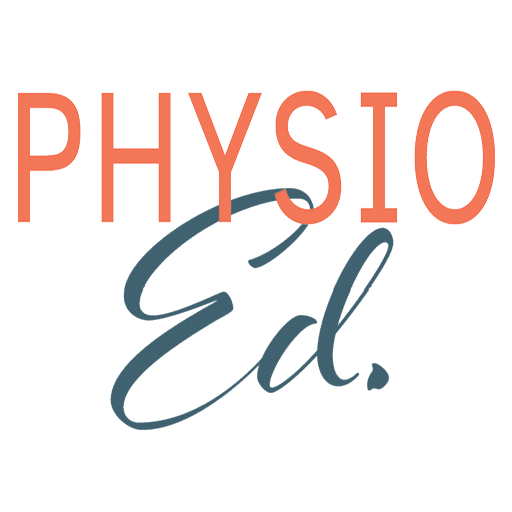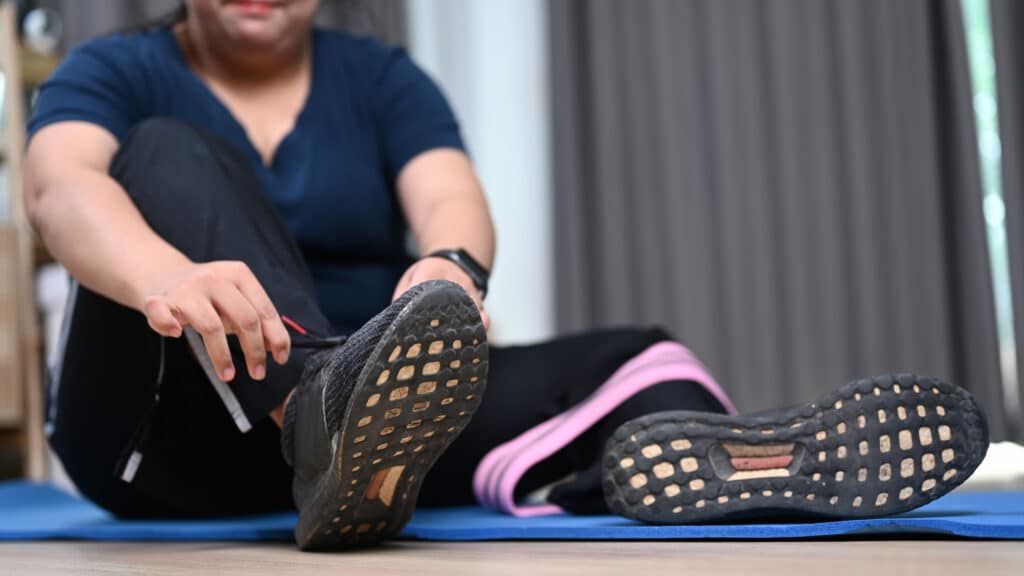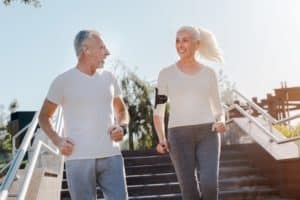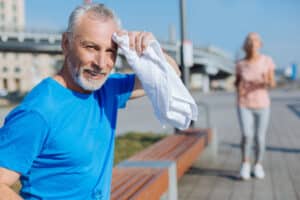As health risks increase with age, adopting a regular fitness routine becomes more important than ever. For seniors, prioritizing weight loss can be life-changing.
So what type of workout routine is best for seniors trying to lose weight?
In this article, we’ll explore why losing weight is vital for living a healthy life, and how you can safely get started on your weight loss journey.
Why It Is Important to Lose Weight
If you feel like you’ve gained a little weight in the last few years, you’re not alone.
According to the CDC, the American rate of obesity jumped from 30% in 2000 to almost 42% in 2020. (1)
A sedentary lifestyle can increase your risk of developing heart disease, stroke, diabetes, Alzheimer’s disease, high blood pressure, and more. (2)
Let’s take a look at how exercise can contribute to weight loss:
The Benefits of a Regular Exercise Routine
Exercise has a number of benefits for general well-being, including improved mood, higher energy levels, better sleep, and of course weight loss. (3)
When there is an imbalance in how much energy (food) you consume with how much energy you burn with exercise or daily activity, excess energy will be stored around your body as fat. (4)
A regular exercise program and a healthy diet can help you to correct this imbalance. As you begin to move more, your body will learn to use the food you eat as fuel, while utilizing stored fat as an energy source.
Exercise can help to lower your risk of certain preventable diseases, but it can also help you lose weight.
And don’t forget that exercise can be a social activity, too, which can help to ease depression and combat loneliness for many seniors.
Keeping Exercise Consistent and Starting Slowly
For people sixty-five and older, the CDC recommends at least 150 minutes (or about 2 1/2 hours) of moderate-intensity exercise per week. This can include anything from brisk walks to aquatic exercise or dance classes. (1)
If you’re new to exercise, simply start by taking a walk around the block or walking up and down the stairs in your building a few times. If you start exercising too aggressively too soon, you could wind up overly sore, or even injured.
As you learn how your body reacts to exercise, you can gradually increase the intensity of your sessions by making walks longer or walking with friends, or even adding some strength training into your routine.
If you are feeling confident and need a little variety, your local gym or recreation center will often have senior-friendly classes, typically in lower volume hours when the gym is less crowded. Senior classes can be a great way to get your daily physical activity while also making new friends and getting to know your community.
The Best Types of Exercise for Losing Weight
Starting a new exercise routine can be challenging, but it can also be fun! Here are some simple ways you can begin exercising with minimal stress.
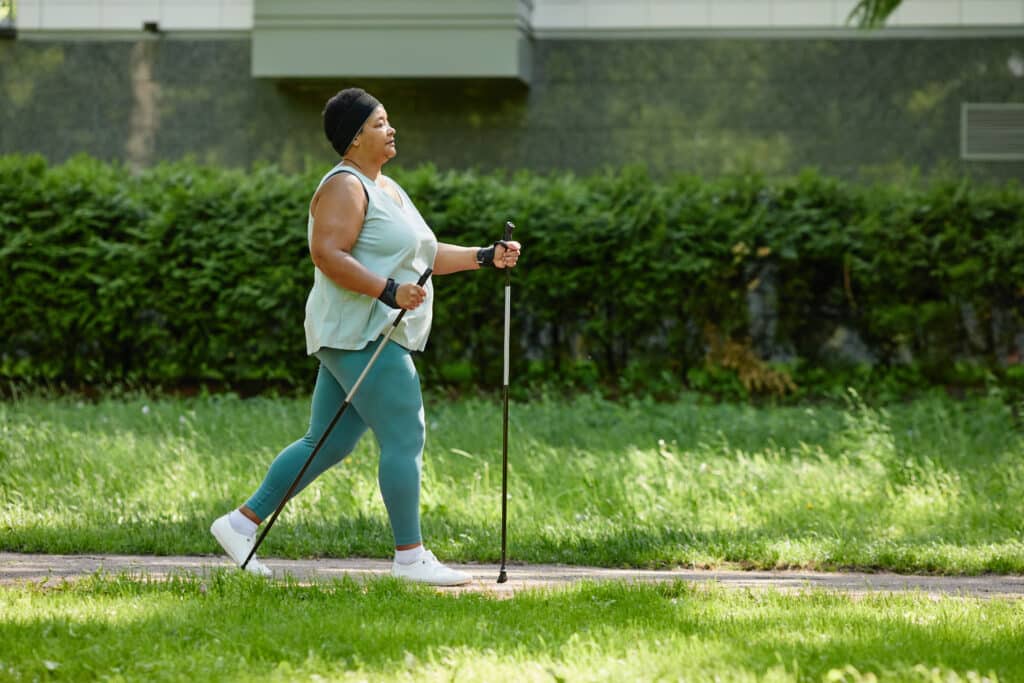
You Have to Walk Before You Can Run
High-impact activities like running can be a shock to your muscles and joints if you are sedentary, especially if you are overweight. Walking slowly is one of the best ways to prepare your body to begin exercising more frequently.
Simply walking is a safe, simple, and free way to build bone density and muscular strength (both of which are important for older adults) while you begin your weight loss journey. (5)
150 minutes of exercise can be divided into daily twenty-five-minute walks, providing a great starting point for consistency in your exercise program while giving your body time to adapt.
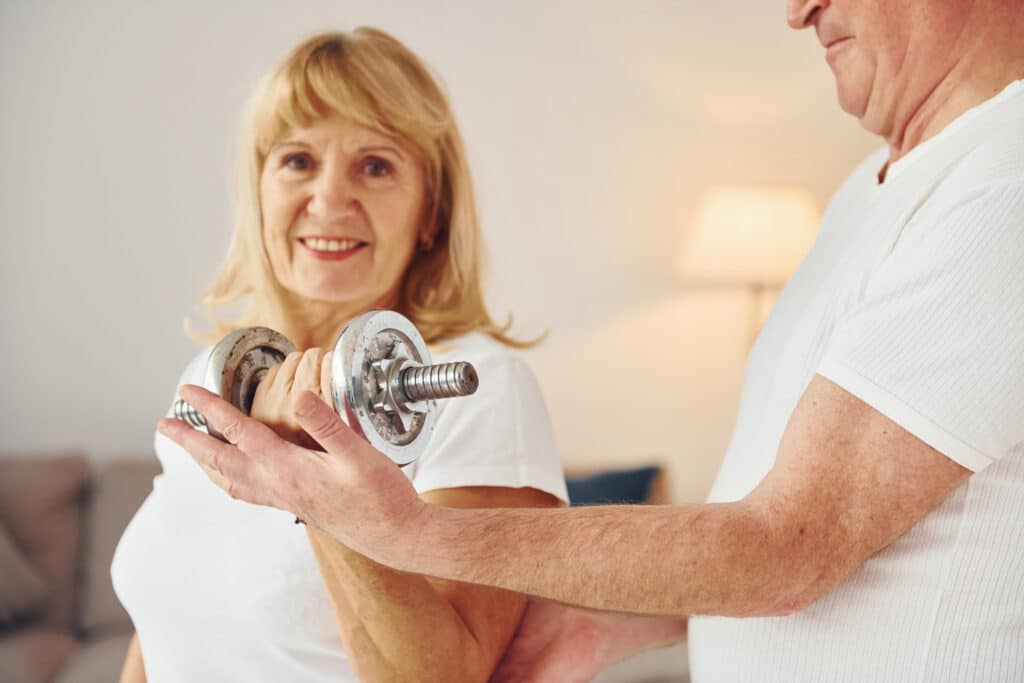
Weight Training for Weight Loss Goals
Another popular misconception is that cardiovascular exercise like jogging, cycling or water exercises are the only way to lose weight.
Resistance training refers to an activity that requires your muscles to contract to lift weight against the force of gravity. Adding resistance exercises into your routine can benefit your workouts in a couple of different ways:
First, building increased muscular strength can counter some age-related conditions like osteoporosis and sarcopenia. By building and maintaining healthy muscle mass, you can prevent a gradual decline in bone and muscle tissue. (6)
Secondly, improving muscle mass can burn calories. Your muscles require fuel to function which increases your metabolism, or your body’s use of stored energy. Extra muscle requires extra effort from your metabolism, which will burn more calories overall.
Once again, it’s important to start slow and build your workout routine, and you don’t always need equipment.
Begin by simply using your body weight as your source of resistance by focusing on simple bodyweight exercises like squats and lunges, and gradually incorporate weights or other equipment for variety and an added challenge.
Not sure where to start? Check out the Physio Ed Fit Kit and our wide variety of tutorials and classes. This resource provides you with all the tools you need to start adding resistance to your exercise program.
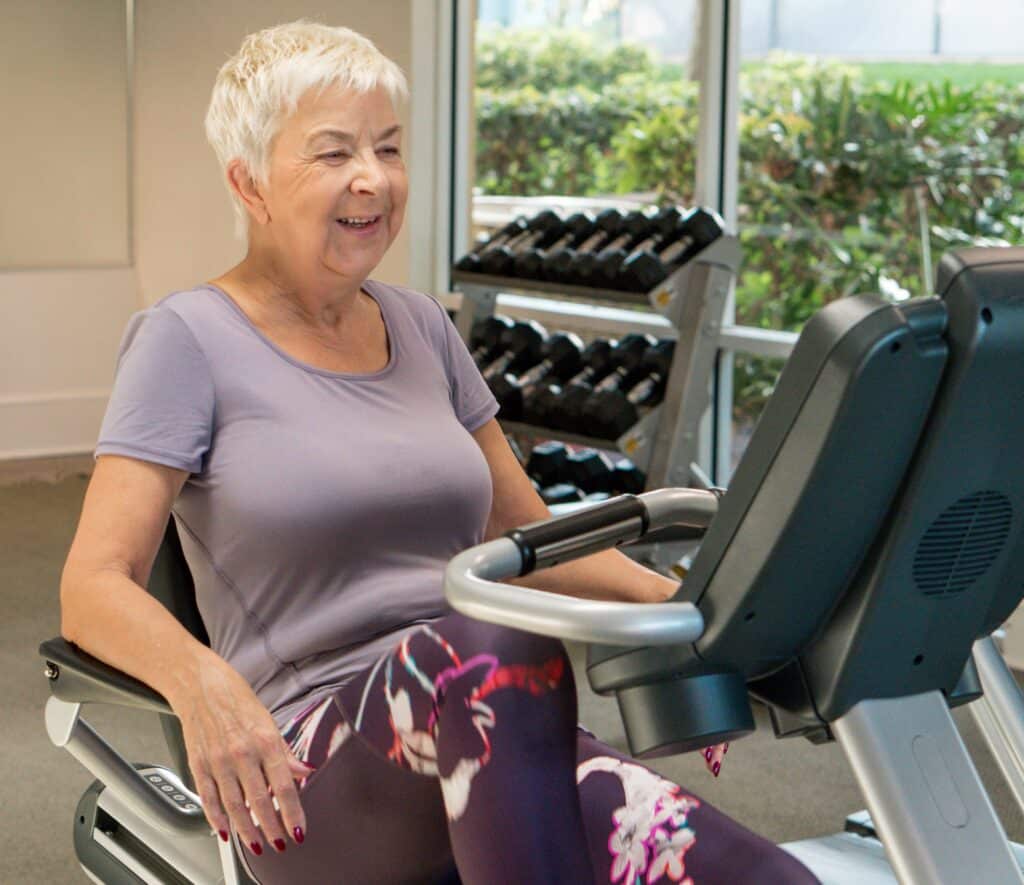
Recumbent or Stationary Bike
Many gyms and fitness facilities have a variety of stationary bike options, including recumbent bikes. Stationary bikes provide many of the benefits of cycling with a low risk of falls or other accidents that might occur outdoors. (7)
Using a stationary bike is a low-impact way to get your body moving. Cycling can build strength and endurance, especially in the lower body while burning calories.
Overweight beginners may want to start with a recumbent bicycle (like the one in the image above) to allow time to adapt to the movement. The reclined position provides a more approachable starting point, especially if you have a history of neck, knee, or low back pain.
After a period of time, you may begin to increase the intensity of your cycling sessions, or even try an upright stationary bike.
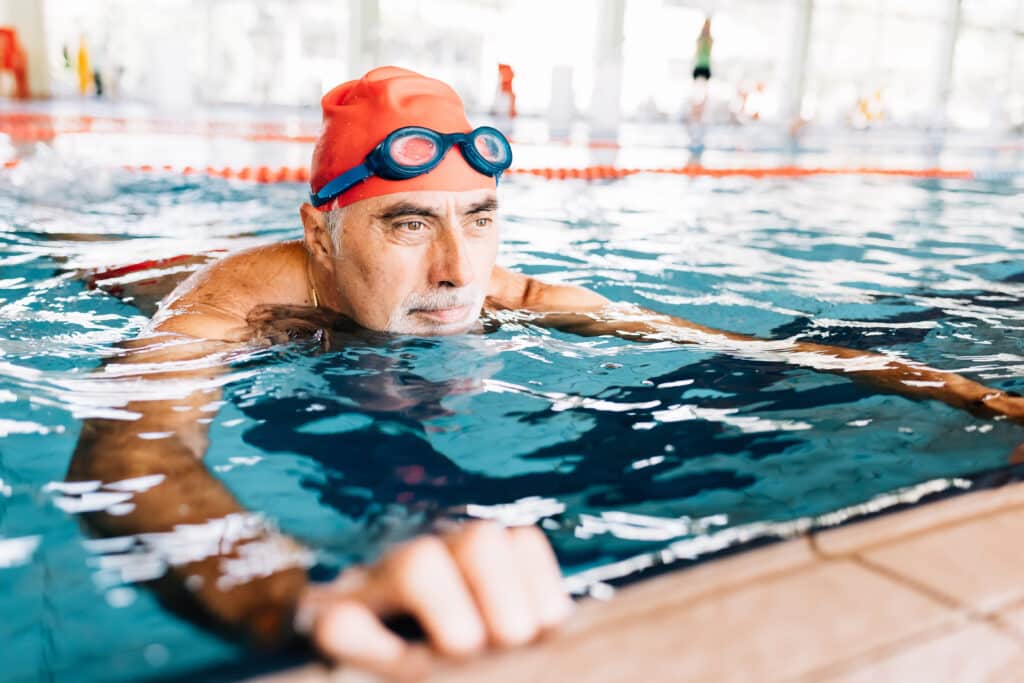
Water Aerobics
Swimming or working out in the water can be another effective way to build strength and lose weight. If you are prone to knee pain when doing exercise like walking or cycling, getting into the pool can help to temporarily reduce the load on your joints, especially when jumping.
Water also provides resistance, and many gyms offer various aquatic exercise programs incorporating pool-based exercise equipment that can gently increase the effort required for movements in the pool. Research shows that aquatic exercise is effective in burning fat and improving explosive strength in older people.
Please note: it’s best not to exercise alone in a pool. If you are interested in pool-based exercise, inquire with a local pool-equipped gym or fitness center near you to get the help you need to get started safely.
Getting Started On Your Weight Loss Journey
If you are an overweight or obese beginner, getting started may seem like the hardest part, but you have resources available to you.
First, it is always a good idea to consult with your doctor to determine what exercises are right for you. Some types of exercise might not be suitable for certain people and conditions.
Your doctor can also provide insight and guidance in the event that it is appropriate for you to work with a physical therapist or a qualified sports medicine professional. Having a guide in your journey to losing excess weight can often be the key to success, as well as avoiding or treating injuries.
Finally, if you are looking for an easy and accessible way to get moving at home, Physio Ed offers a variety of classes from exercise basics to Pilates and yoga to get you started.
Conclusion
- Exercise and following a balanced diet are a winning combination to help you lose weight and feel great.
- Breaking your exercise program down into manageable chunks to build consistency and meet the weekly suggested 150-minutes of exercise
- A combination of cardiovascular and resistance training can provide benefits for weight loss and help stave off a variety of other age-related conditions.
- Seek advice from your doctor, PT or other qualified professional if you’re unsure what is best for your needs.
Resources:
- The Centers for Disease Control and Prevention: https://www.cdc.gov/physicalactivity/basics/older_adults/index.htm
- American Family Physician https://www.aafp.org/pubs/afp/issues/2010/0101/p55.html
- The Mayo Clinic: “Exercise: 7 Benefits of Regular Activity” https://www.mayoclinic.org/healthy-lifestyle/fitness/in-depth/exercise/art-20048389
- Klaas R Westerterp, Exercise for weight loss, The American Journal of Clinical Nutrition, Volume 110, Issue 3, September 2019, Pages 540–541, https://doi.org/10.1093/ajcn/nqz070
- The National Institute of Health https://newsinhealth.nih.gov/2016/03/benefits-walking
- The National Institute on Aging: https://www.nia.nih.gov/news/how-can-strength-training-build-healthier-bodies-we-age
- Bouaziz, W., Schmitt, E., Kaltenbach, G. et al. Health benefits of cycle ergometer training for older adults over 70: a review. Eur Rev Aging Phys Act 12, 8 (2015). https://doi.org/10.1186/s11556-015-0152-9
- Pereira Neiva H, Brandão Faíl L, Izquierdo M, Marques MC, Marinho DA (2018) The effect of 12 weeks of water-aerobics on health status and physical fitness: An ecological approach. PLoS ONE 13(5): e0198319. https://doi.org/10.1371/journal.pone.0198319


